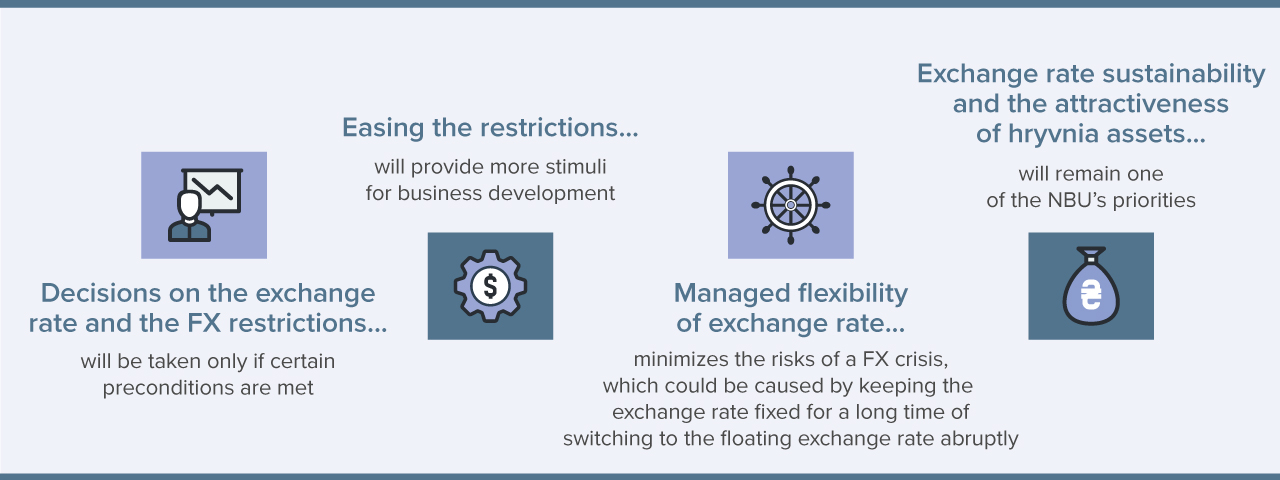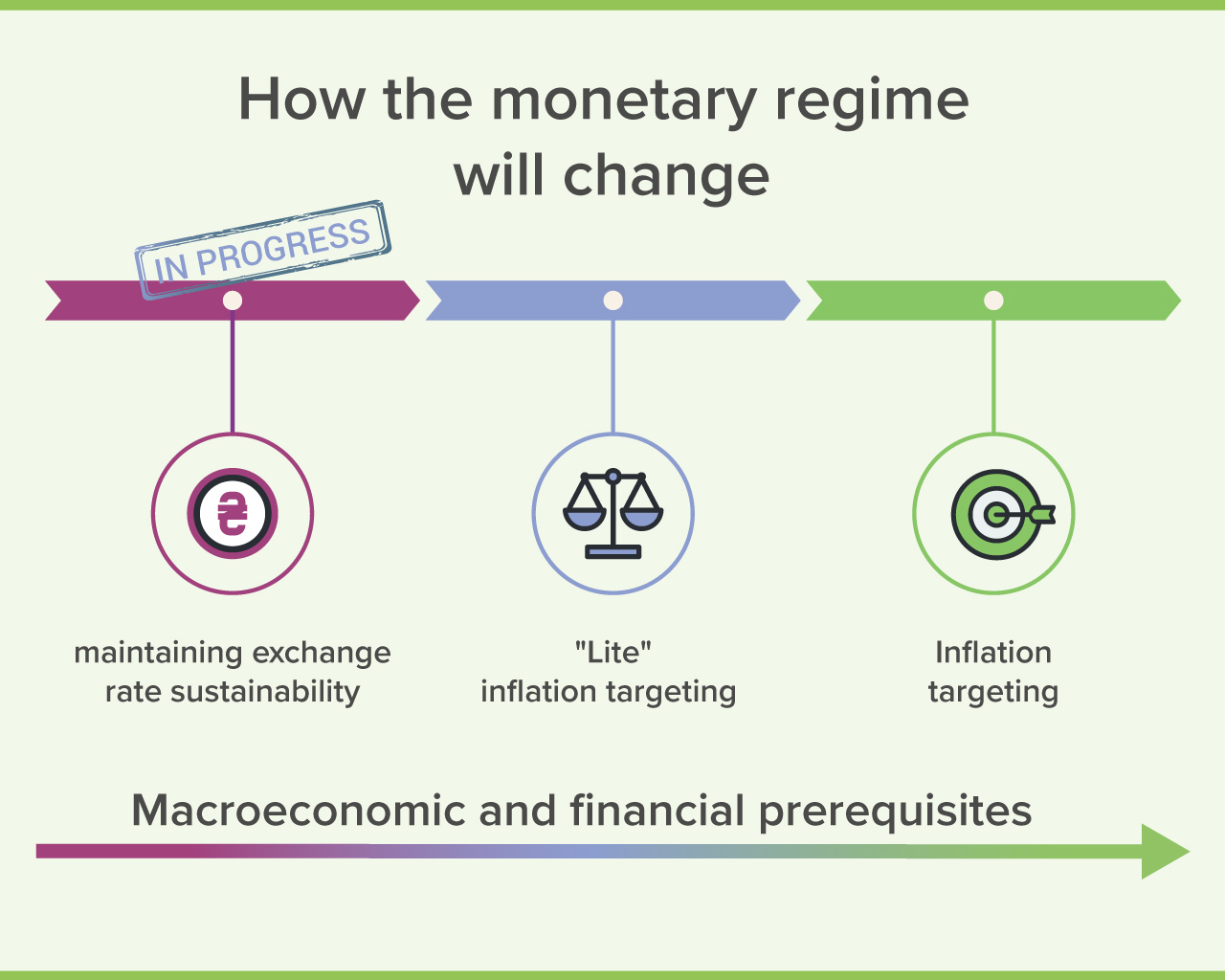- National Bank of Ukraine
- News
- All news
- What does the NBU plan to do with the exchange rate and FX restrictions?

In July, the NBU published the Strategy for Easing FX Restrictions, Transitioning to Greater Flexibility of the Exchange Rate, and Returning to Inflation Targeting ("the Strategy"). The document contains a lot of specialized terms and may be difficult to understand. This page was created to let anyone easily grasp the NBU’s plans regarding its exchange rate and monetary policies.

Why did the NBU move to more exchange rate flexibility, and why is it gradually easing FX restrictions?
The NBU was forced to fix the official exchange rate and introduce strict FX restrictions on 24 February 2022. The central bank has consistently emphasized that these decisions are temporary and justified.
The decisions made it possible to prevent panics, ensure the stable operation of the financial system, and helped businesses and households adjust to the full-scale war. However, the fixed exchange rate regime and FX restrictions comes with both benefits and costs, and over time, the costs could outweigh the benefits.
For example, FX restrictions are gradually losing their effectiveness, and the society might question the adequacy of the current exchange rate. All of this may lead to attempts to avoid capital outflow restrictions and cause growth in the shadow economy.
Most Ukrainians remember well the currency crises of 2008 and 2014–2015, when the national currency weakened significantly. The depth of these crises was substantially aggravated by the long-term fixing of the exchange rate. Keeping the exchange rate at the same level for many years usually ends in the same way, resulting in the accumulation of FX imbalances, the depletion of international reserves, forced deep devaluation, and a significant economic downturn. This is why most countries do not use fixed exchange rate regimes and tight restrictions and why the NBU switched to managed flexibility of the exchange rate in October 2023 and plans to continue easing FX restrictions.
Ukraine has already had positive experience with a floating exchange rate. After the 2014–2015 crisis, the NBU switched to the floating exchange rate regime. Over the following years, and until the full-scale invasion, the hryvnia exchange rate fluctuated in both directions, weakening and strengthening in line with market trends. The NBU, by selling or buying foreign currency in the market, only smoothed out excessive exchange rate fluctuations, neither counteracting nor reinforcing the underlying exchange rate trends.
Thanks to this flexibility, Ukraine did not accumulate FX imbalances and no longer experienced FX crises as before. Despite some fluctuations, the exchange rate remained relatively stable throughout the entire floating exchange rate period. In addition, the NBU has been steadily accumulating international reserves during this time.
This time returning to a more flexible exchange rate regime will also help strengthen the resilience of the economy and the FX market to external and internal changes.
Does it mean the NBU returned to the same floating exchange rate as before?
No. The NBU first moved to managed exchange rate flexibility. This is due to the specifics of how the economy is functioning amid the full-scale war.
As the country's export capabilities, as well as inflows of investment to Ukraine, are limited due to the war, the FX market is constantly experiencing a significant shortage of foreign currency. In view of this, it is too early to return to a floating exchange rate whereby the NBU only smooths out excessive fluctuations in the market.
Instead, the NBU will use managed exchange rate flexibility to cover this structural shortage of foreign currency in the market. This will allow the hryvnia to weaken (when the shortage increases) as well as strengthen (when it decreases). In addition, especially in the early stages of the new exchange rate regime, the NBU will significantly limit the exchange rate's movements in both directions.
Thus, the NBU's foreign currency sales will help maintain exchange rate sustainability, while high interest rates on hryvnia deposits will continue to protect savings from inflation (more on this below).

Should we expect the hryvnia to weaken sharply while under managed flexibility of the exchange rate?
The public often associates any decisions the NBU takes with regard to its exchange rate policy with a sharp depreciation of the hryvnia. This is due to Ukraine’s bitter experience, when the NBU was forced to let the hryvnia float due to the depletion of international reserves and the inability to maintain a fixed exchange rate.
But the situation is different now. Why is it so?
First, in previous years, the NBU:
Second, the NBU made thorough preparations for the transition to managed exchange rate flexibility. The central bank took this step as required macroeconomic and financial preconditions had been met. So the transition was controlled.
The transition to managed exchange rate flexibility does not mean that the NBU has completely let go of the hryvnia exchange rate. The NBU remains present in the market and will cover the structural deficit of foreign currency. Thanks to this, the hryvnia can not only weaken, but also strengthen.
The NBU will gradually increase the flexibility of the exchange rate when the necessary preconditions are in place, particularly when the foreign exchange market regains its ability to self-balance. In other words, exchange rate flexibility will increase when the NBU realizes that the exchange rate can move in both directions with less NBU involvement.
Which FX restrictions will the NBU ease first?
The strategy envisages that this process will take place in three stages.

At the first stage, the NBU's efforts are aimed at minimizing the existence of multiple exchange rates. This involves narrowing and/or keeping the spread between the cash and official exchange rates low. To this end, the NBU has already taken a number of measures aimed at both increasing the ability of the banks to meet clients’ demand for cash foreign currency and expanding the ability of clients to purchase cashless foreign currency, thus reducing the pressure on the cash exchange rate.
The NBU is also gradually increasing opportunities for businesses to conduct trading operations. Significant progress has already been made in this area. In particular, as early as mid-2022, businesses were allowed to import any goods from abroad.
The third direction provides for facilitation of new investments. With this in mind, the NBU has already allowed businesses and households to partially repay "new" loans to foreign creditors, as well as loans secured by a guarantee from an international financial institution, export credit agency, etc. In addition, the NBU will consider granting permission to transfer abroad dividends received by foreigners in Ukraine. All of this is important to encourage businesses and international companies to invest in Ukraine. At the same time, all easing measures of the first stage will apply specifically to the new loans or dividends, meaning those received shortly before or after the relevant decisions were taken. This is necessary to prevent the depletion of international reserves and maintain the sustainability of the FX market.
At the second stage of loosening the FX restrictions, the NBU will focus on:
At stage three, the NBU will slowly roll the FX restrictions back to where they were before the full-scale war broke out. The regulator will authorize repayments on all of the loans and investments, while households will be able to conduct more transactions, such as transfers to foreign-issued cards from hryvnia cards. The NBU will also gradually authorize transactions with derivatives, including swap and forward transactions (more on those here), make it possible for foreigners to take out loans, and allow investments abroad.
The steps within the stages may be reshuffled to help the economy recover and to increase the FX market’s and the financial system’s performance.
When does the NBU plan to move to the floating exchange rate and continue to ease FX restrictions?
The NBU does not set any specific dates for a return to the floating exchange rate or the easing of restrictions. Any steps in this direction will be taken only when the appropriate sustainable preconditions are in place.
The NBU will take into account the following indicators:
If all indicators are at normal levels, the NBU will continue to ease FX restrictions and will increase exchange rate flexibility. At the same time, the NBU will act gradually and cautiously to maintain the sustainability of the FX market. Before taking each next step, the NBU will analyze whether all the necessary preconditions have been met. This will help minimize the likelihood of reintroducing the restrictions.
What if something goes wrong?
The level of uncertainty associated with russia’s full-scale aggression is still high. If risks rise, the implementation of the Strategy might be paused or even some steps might be cancelled.
Maintaining exchange rate sustainability will remain one of the NBU’s priorities. This is important for sustainable disinflation and the resilience of the financial system.
How will the switch to inflation targeting take place?
Returning to inflation targeting with a floating exchange rate, a regime that was in place prior to the full-scale war, is the ultimate goal of the Strategy’s implementation. This regime is precisely what will enable the NBU to simultaneously ensure price and financial stability in the long run and to support sustainable economic growth.
The NBU’s return to inflation targeting with a floating exchange rate will also be spaced out in time and will only take place if the prerequisites are met. This is not something that can be achieved in short order.
In the early stages of the Strategy’s implementation, the NBU’s key policy rate will continue to play the role of an auxiliary tool to maintain the sufficient attractiveness of hryvnia assets as a guarantee of exchange rate sustainability. In other words, the NBU policy will continue to be aimed at ensuring that by making hryvnia term deposits, households can protect their savings from losing value. This is important in restraining demand in the FX market, which in turn will make it possible to maintain exchange rate sustainability and ensure a further decline in inflation.
Going forward, inflation will gradually take over as the anchor of macrofinancial stability, as was the case before the onset of the full-scale war. The key policy rate will regain its status as the main monetary instrument.
Eventually, the NBU will return to the monetary regime it was operating prior to the full-scale war.

What will happen to the NBU’s key policy rate during the Strategy’s implementation? How will it affect interest rates on hryvnia retail deposits?
Thanks to the faster-than-anticipated pullback in inflation, the sustainability of the FX market, and the record level of international reserves, the NBU has already switched to the cycle of key policy rate cuts.
However, at every stage of the Strategy’s implementation, the NBU will maintain a level of the key policy rate that will allow households to protect their funds from inflation by putting them into hryvnia assets (term deposits and domestic government debt securities).This is important for maintaining the attractiveness of hryvnia savings and reducing the demand for foreign currency.
|
|
Subscribe to news alerts |